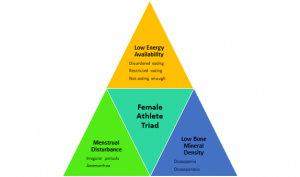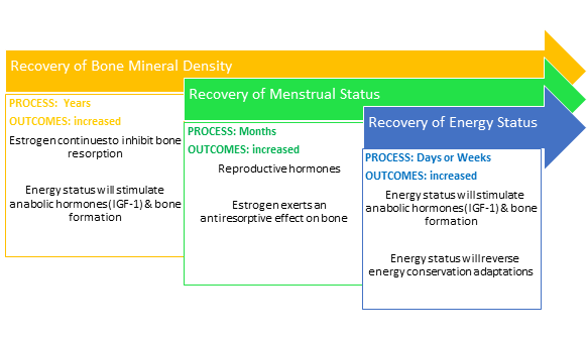Nancy’s Health: Female Athlete Triad
Nancy’s Story Continues…
The emergency physician was more concerned about Nancy’s appearance & how she injured herself.
A more comprehensive history & examination followed.
Assessment findings:
- Extreme fatigue (stated she always felt tired, would fall asleep if she sat still for more than 5 minutes)
- Weight loss (Nancy’s BMI is 15.7)
- Absence of menstrual periods for the last 6 months (stated she had only 2 very light periods in the last year)
- Eating disorder – fasting, binging, self-induced vomiting (indulged in all of these practices regularly)
- Extreme exercise (Nancy ran 10km each day, had morning & after school practices, games & competitions, & competed in a number of events each weekend)
Based on clinical findings, Nancy was diagnosed with:

Female Athlete Triad
- Low energy availability
- Menstrual dysfunction
- Poor bone health
Triad Screening
Early detection of athletes at risk is critical.
It is recommended that screening for the Triad be part of the Pre-Participation Physical Evaluation.
Screening Questions:
- Have you ever had a menstrual period?
- How old were you when you had your first menstrual period?
- When was your most recent menstrual period?
- How many periods have you had in the past 12 months?
- Are you presently taking any female hormones (oestrogen, progesterone, birth control pills)?
- Do you worry about your weight?
- Are you trying to or has anyone recommended that you gain or lose weight?
- Are you on a special diet or do you avoid certain types of foods or food groups?
- Have you ever had an eating disorder?
- Have you ever had a stress fracture?
- Have you ever been told you have low bone density (osteopenia or osteoporosis)?
Treatment
The three components of the Triad recover at different rates with the appropriate treatment.
Recovery of energy status is typically observed after days or weeks of increased energy intake and/or decreased energy expenditure.
Recovery of menstrual status is typically observed after months of increased energy intake and/or decreased energy expenditure, which improves energy status.
Recovery of bone mineral density may not be observed until years after recovery of energy status and menstrual status has been achieved. IGF-1, insulin-like growth factor-1.


